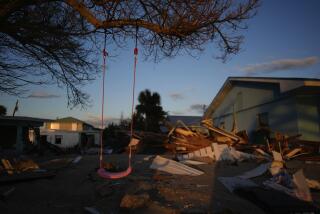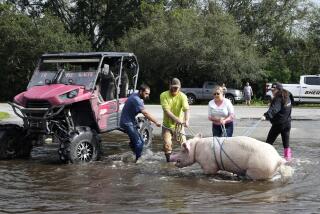Ecology, Development Collide as Everglades Fights for Survival
- Share via
HOMESTEAD, Fla. — After parking her van on the side of a paved road that cuts across Everglades National Park, Sue Haley hopped out and headed off through the waist-high saw grass toward an alligator hole in a small stand of cypress trees 300 yards away. About halfway there she stopped.
“See this water?” she asked. Looking down toward her rubber-booted feet, Haley aimed a finger at the spongy carpet of algae on which she walked, the green tangles of carnivorous bladderwort plant and the minnows swimming around her toes. The clear, still water crested just above her ankles.
“Normally,” said Haley, 31, a park ranger here for eight years, “the water would be almost up to my knees at this time of year. But last summer we had drought, no water has been released into the park at all this year, and already--early in November--animals are congregating around water holes in order to find food.
“It gets so frustrating,” she added. “What the Everglades needs is lots of support and respect for water as a finite resource. But we take it for granted. And there just isn’t enough water to (develop) South Florida . . . and save this park too.”
The seasonal change from wet to dry is always a critical time in the Everglades, testing the survival capabilities of scores of unique plants and animals that live here in a delicate web unlike any other on Earth. Over the winter, alligators, raccoons, herons, mosquito fish and a wide variety of other links in the food chain will gather at water holes to play out a timeless, elemental drama of life and death.
But this year the park itself is fighting to survive. The Everglades, under siege from pollution, an invasion of exotic species of plants and animals, urban development and unnatural water levels regulated by computer, teeters on the edge of what former Supt. Mike Finley called “ecosystem collapse.”
Most scientists believe that with a more natural water distribution pattern and less interference from people, the Everglades can be saved. But for some rare native animals, it may already be too late. The Everglades snail kite is disappearing, the population of endangered Florida panthers has dropped to about 30 and the number of wading birds in the park has declined to 10% of 1930s levels.
“Our prediction is that we’re going to see no successful wading bird nesting in the park this year,” says Everglades researcher John Ogden. “With wood storks, egrets, and white ibis, the situation is in crisis.”
The Everglades is also beset with serious problems of contamination caused by agricultural runoff rich in nutrients. Those nutrients have fueled a proliferation of plants such as cattails, which for years have been spreading at the rate of five acres a day, choking off naturally occuring species.
Mercury is also a threat. This summer, anglers were warned not to eat bass and catfish caught in the park, and just last month an autopsy on a Florida panther revealed enough mercury to kill a human.
The 2,200 square miles of freshwater marshland that make up Everglades National Park occupies almost the entire tip of the Florida peninsula, but it is a mere one-tenth of a vast wetlands system that begins in the Kissimmee Valley in the center of the state and includes Lake Okeechobee as well as millions of acres of drained and diked land that now produces sugar cane, tomatoes and beans.
Flanked by some 4.5 million residents of Florida’s east and west coasts, no federal preserve is closer to a major urban area and, according to the Wilderness Society, no park is closer to extinction. Saving it is now the responsibility of Robert S. Chandler, who in December succeeds Finley as superintendent.
Chandler, 53, is a 30-year veteran of the National Parks Service who comes here after six years as superintendent of Olympic National Park in Washington. From 1978 to 1983 he held the top job at Santa Monica Mountains National Recreation Area.
With the Everglades facing increasing pressure from oil companies who want to drill in adjacent offshore waters, as well as a host of complex water delivery issues, Chandler knows what he’s up against. “The park is in real trouble; that’s reality,” he says. “But this is not the time to simply throw up our hands.”
The crisis that grips the Everglades did not come about overnight. For several decades attacks on the wetlands went almost unnoticed, provoking no public outcry in the same way that, for example, a plan to level the landscape of Yosemite or fill in the Grand Canyon surely would. The Everglades, after all, looks like an immense swamp, a forbidding expanse of grass and scrub trees, hot and desolate, crawling with dangerous reptiles and the perfect breeding ground for blood-thirsty mosquitoes that will later blow into Miami and annoy people to slap-happy distraction.
But it is also a river--a “river of grass” in environmentalist Marjory Stoneman Douglas’ words--that runs 6 inches deep, 50 miles wide and flows gently southward for 120 miles, from Lake Okeechobee in the center of the state to the peninsula’s tip. Overlaying the Biscayne Aquifer, the Everglades also is the source of drinking water for 90% of South Florida.
The Everglades’ problems are myriad, but they all begin--and end--with water. Soon after the park was established in 1947, the demand for flood control and more dry land for homes and farms outside its borders led to the construction of 1,500 miles of levees and canals that crisscross the Everglades and block the free flow of water.
Now, decisions about who gets water--how much and when--are made not by nature but by hydrologists working for the state. And when those decisions run contrary to the natural nesting cycles of birds, or the seasonal food needs of fish, for example, wildlife suffers.
“What we’ve got is a robot Everglades which doesn’t work as well as it did when nature controled it,” says Joe Podgor of Friends of the Everglades, a public interest group begun by Douglas 20 years ago. “We’ve made a mess of it, and now we’ve got to put the system back the way God made it.’
That won’t be easy. While militant environmentalists like Podgor suggest breaking down levees and filling in canals to restore the Everglades, that is unlikely to happen. More probable is a system of water control that is driven more by rainfall than by the desires of powerful farming interests and coastal residents who favor green lawns.
Meanwhile, some extraordinary signs have emerged indicating just how dire the situation is. In October, 1988, the U.S. attorney in Miami, Dexter Lehtinen, filed a lawsuit charging that state regulatory agencies had “breached the public trust” by allowing polluted water from adjacent agricultural areas to flow into the Everglades. The suit asks a federal judge to monitor the agencies that are supposed to be protecting the park.
The U.S. Army Corps of Engineers, which over 20 years dug the canals and installed the floodgates that now define South Florida, has also begun studies on how to regulate the flow of water into the park so that it more closely mirrors the natural cycle of wet and dry.
And, in a measure considered vital to the preservation of wading birds and the Florida panther, a bill before Congress would add 107,000 acres to the park at its northeast corner. Chandler says working for passage of that bill “is one of the first things on my agenda.’
No one seriously suggests that Everglades National Park is dead yet. But according to Friends of the Everglades’ Podgor, “It is on life-support, like a patient with an IV drip, hanging on the end of the line.
“We’re going to have to come to grips with the water budget, and live within our means,” he says. “In 20 years the Glades could turn into a field of cattails, and Lake Okeechobee could be a slime pit.
“The good news may be that things are so bad than even the most simple-minded among us--and I mean elected officials--can see the problems clearly. The answer is to put the system back so that it works the natural way. If not, we’ll not only lose the Everglades, but we won’t have anything to drink.”
More to Read
Sign up for Essential California
The most important California stories and recommendations in your inbox every morning.
You may occasionally receive promotional content from the Los Angeles Times.










